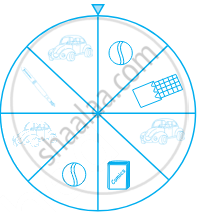Advertisements
Advertisements
Question
A box contains cards numbered 3, 5, 7, 9, .... , 35, 37. A card is drawn at random from the box. Find the probability that the number on the card is a prime number.
Solution
Given numbers 3, 5, 7, 9, .... , 35, 37 form an AP with a = 3 and d = 2.
Let Tn = 37. Then,
3 + (n − 1)2 = 37
⇒ 3 + 2n − 2 = 37
⇒ 2n = 36
⇒ n = 18
Thus, total number of outcomes = 18.
Let E be the event of getting a prime number.
Out of these numbers, the prime numbers are 3, 5, 7, 11, 13, 17, 19, 23, 29, 31 and 37.
Number of favourable outcomes = 11.
∴ P(getting a prime number) = P(E) = `("Number of outcomes favourable to" E )/"Number of all possible outcomes"`
Thus, the probability that the number on the card is a prime number is `11/18`.
APPEARS IN
RELATED QUESTIONS
All the red face cards are removed from a pack of 52 playing cards. A card is drawn at random from the remaining cards, after reshuffling them. Find the probability that the drawn card is of red colour.
Cards marked with number 3, 4, 5, ...., 50 are placed in a box and mixed thoroughly. A card is drawn at random form the box. Find the probability that the selected card bears a perfect square number.
All the red face cards are removed from a pack of 52 playing cards. A card is drawn at random from the remaining cards, after reshuffling them. Find the probability that the drawn card is an ace.
Two dice are rolled once. Find the probability of getting such numbers on the two dice, whose product is 12.
A box contains 80 discs which are numbered from 1 to 80. If one disc is drawn at random from the box, find the probability that it bears a perfect square number.
A die is thrown once. What is the probability of getting an odd number?
If \[\bar{E}\] denote the complement or negation of an even E, what is the value of P(E) + P(\[\bar{E}\]) ?
A box contains 80 discs, which are numbered from 1 to 80. If one disc is drawn at random from the box, find the probability that it bears a perfect square number.
What is the probability that an ordinary year has 53 Mondays?
Two dice are thrown together. The probability of getting the same number on the both dice is
From a well-shuffled deck of 52 cards, one card is drawn at random. What is the probability of getting a queen?
Three different coins are tossed simultaneously. Find the probability of getting exactly one head.
A die is thrown, find the probability of getting:
a number not greater than 4.
A coin is tossed twice. Find the probability of getting: two heads
A bag contains a black ball, a red ball and a green ball, all the balls are identical in shape and size. A ball is drawn from the bag without looking into it. What is the probability that the ball drawn is:
(i) a red ball
(ii) not a red ball
(iii) a white ball.
Two coins are tossed together. Find the probability of getting: at least one head
The total number of events of throwing 10 coins simultaneously is ____________.
In a throw of a dice, the probability of getting an even number is the same as that of getting an odd number.
At a Birthday Party, the children spin a wheel to get a gift. Find the probability of getting a ball

A bag contains 25 cards, numbered through 1 to 25. A card is drawn at random. What is the probability that the number on the card drawn is multiple of 5?
